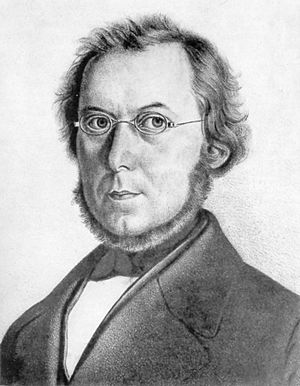Hugo von Mohl facts for kids
Quick facts for kids
Hugo von Mohl
|
|
|---|---|

Hugo von Mohl
|
|
| Born | 8 April 1805 |
| Died | 1 April 1872 (aged 66) |
| Nationality | German |
| Scientific career | |
| Fields | botany |
| Author abbrev. (botany) | Mohl |
Hugo von Mohl (born April 8, 1805 – died April 1, 1872) was an important German botanist from Stuttgart. He is famous for being the first person to use the word "protoplasm". This word describes the living part of a cell.
Contents
Early Life and Education
Hugo von Mohl was born in Stuttgart, Germany. His father, Benjamin Ferdinand von Mohl, was a statesman. From a young age, Hugo loved studying plants and minerals. He spent his free time learning about them.
In 1823, he started studying at the University of Tübingen. He studied medicine there and graduated with high honors. After that, he moved to Munich. There, he met many famous botanists. This helped him decide to focus his career on studying plants.
Discoveries and Research
Hugo von Mohl began his detailed studies of plant structure in 1828. He became a professor of botany at Tübingen in 1832. He stayed there for the rest of his life. He was very skilled at using microscopes and preparing slides for study. He taught himself much of what he knew about botany.
The Discovery of Protoplasm
One of Mohl's biggest contributions was his work on the living parts of plant cells. In 1844, he showed that the "protoplasm" is responsible for the movements seen inside cells. He was the first to use this specific word.
He also identified the "primordial utricle." This is the protoplasm that lines the inside of a plant cell. He was also the first to describe how protoplasm behaves when a cell divides.
Understanding Cell Division
In 1835, Hugo von Mohl was the first to see and describe the process of cell division under a microscope. He observed this happening in a type of green algae called Cladophora glomerata. His observations helped change how scientists understood how cells form.
Insights into Cell Walls
Mohl also made important discoveries about plant cell walls. He believed that cell walls grow by adding new layers. This idea is still accepted today. He also explained the true nature of pits in cell walls. He showed that vessels and fibrous cells in plants come from cells. Many people consider him a true founder of the cell theory.
In 1851, he wrote a book called Die vegetabilische Zelle (The Vegetable Cell). This book brought together many ideas about cell formation.
Studies on Plant Structures
Mohl's early research on the structure of palms, cycads, and tree ferns was very important. It laid the groundwork for future studies. He also studied the plant Isoetes in 1840.
Later, he focused on the stems of dicotyledons and gymnosperms. He explained how different types of bark form. He also corrected mistakes about lenticels, which are small pores on plant stems. In 1838, he showed how stomata (tiny pores on leaves) originate. In 1850, he wrote a classic paper on how stomata open and close.
Later Life and Legacy
In 1843, Mohl helped start a weekly science newspaper called Botanische Zeitung. He edited it until he died. He was not known for writing large textbooks. He preferred to focus on his detailed research.
Hugo von Mohl received many honors during his life. He was elected a foreign member of the Royal Society in 1868. He also became a foreign member of the Royal Swedish Academy of Sciences in 1850. His health declined in his later years. He passed away suddenly in Tübingen on April 1, 1872.

